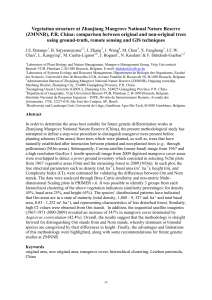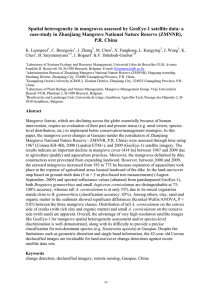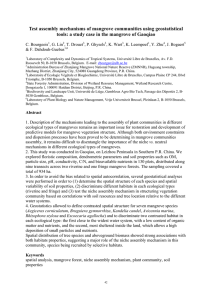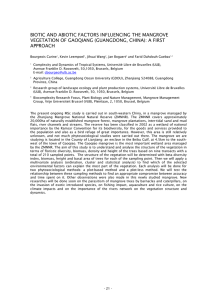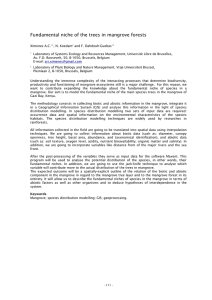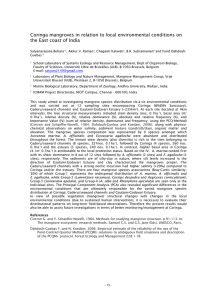Vegetation structure at Zhanjiang Mangrove National Nature Reserve
advertisement
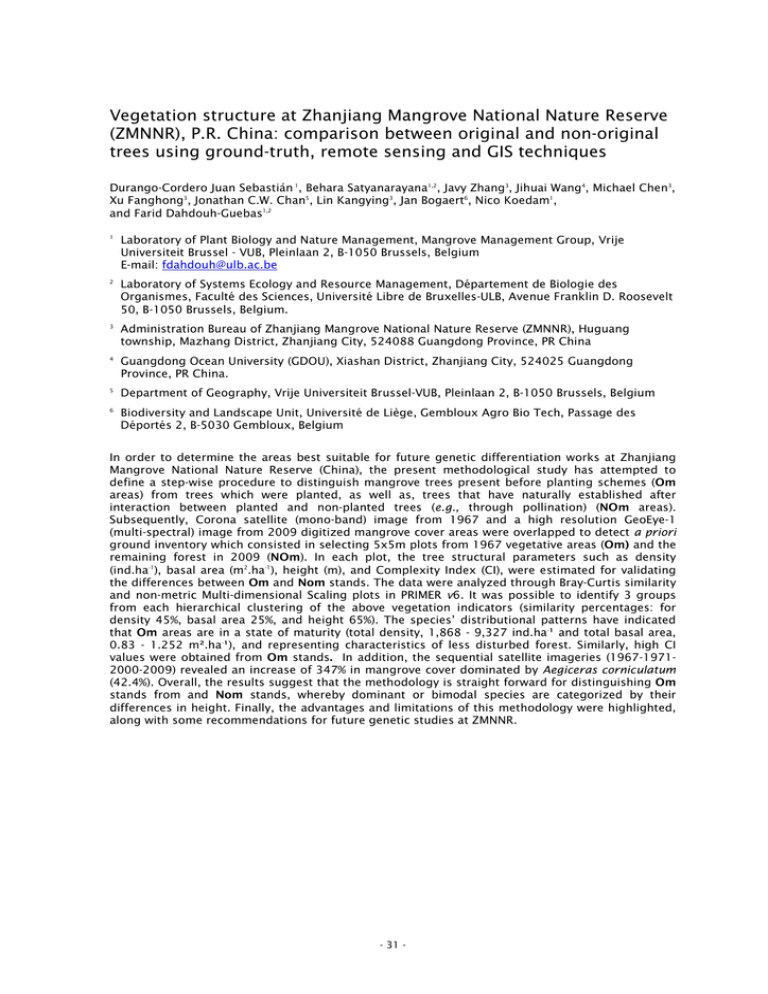
Vegetation structure at Zhanjiang Mangrove National Nature Reserve (ZMNNR), P.R. China: comparison between original and non-original trees using ground-truth, remote sensing and GIS techniques Durango-Cordero Juan Sebastián 1, Behara Satyanarayana1,2, Javy Zhang3, Jihuai Wang4, Michael Chen3, Xu Fanghong3, Jonathan C.W. Chan5, Lin Kangying3, Jan Bogaert6, Nico Koedam1, and Farid Dahdouh-Guebas1,2 1 Laboratory of Plant Biology and Nature Management, Mangrove Management Group, Vrije Universiteit Brussel - VUB, Pleinlaan 2, B-1050 Brussels, Belgium E-mail: fdahdouh@ulb.ac.be 2 Laboratory of Systems Ecology and Resource Management, Département de Biologie des Organismes, Faculté des Sciences, Université Libre de Bruxelles-ULB, Avenue Franklin D. Roosevelt 50, B-1050 Brussels, Belgium. 3 Administration Bureau of Zhanjiang Mangrove National Nature Reserve (ZMNNR), Huguang township, Mazhang District, Zhanjiang City, 524088 Guangdong Province, PR China 4 Guangdong Ocean University (GDOU), Xiashan District, Zhanjiang City, 524025 Guangdong Province, PR China. 5 Department of Geography, Vrije Universiteit Brussel-VUB, Pleinlaan 2, B-1050 Brussels, Belgium 6 Biodiversity and Landscape Unit, Université de Liège, Gembloux Agro Bio Tech, Passage des Déportés 2, B-5030 Gembloux, Belgium In order to determine the areas best suitable for future genetic differentiation works at Zhanjiang Mangrove National Nature Reserve (China), the present methodological study has attempted to define a step-wise procedure to distinguish mangrove trees present before planting schemes (Om areas) from trees which were planted, as well as, trees that have naturally established after interaction between planted and non-planted trees (e.g., through pollination) (NOm areas). Subsequently, Corona satellite (mono-band) image from 1967 and a high resolution GeoEye-1 (multi-spectral) image from 2009 digitized mangrove cover areas were overlapped to detect a priori ground inventory which consisted in selecting 5x5m plots from 1967 vegetative areas (Om) and the remaining forest in 2009 (NOm). In each plot, the tree structural parameters such as density (ind.ha-1), basal area (m2.ha-1), height (m), and Complexity Index (CI), were estimated for validating the differences between Om and Nom stands. The data were analyzed through Bray-Curtis similarity and non-metric Multi-dimensional Scaling plots in PRIMER v6. It was possible to identify 3 groups from each hierarchical clustering of the above vegetation indicators (similarity percentages: for density 45%, basal area 25%, and height 65%). The species’ distributional patterns have indicated that Om areas are in a state of maturity (total density, 1,868 - 9,327 ind.ha-¹ and total basal area, 0.83 - 1.252 m².ha-¹), and representing characteristics of less disturbed forest. Similarly, high CI values were obtained from Om stands. In addition, the sequential satellite imageries (1967-19712000-2009) revealed an increase of 347% in mangrove cover dominated by Aegiceras corniculatum (42.4%). Overall, the results suggest that the methodology is straight forward for distinguishing Om stands from and Nom stands, whereby dominant or bimodal species are categorized by their differences in height. Finally, the advantages and limitations of this methodology were highlighted, along with some recommendations for future genetic studies at ZMNNR. - 31 -
